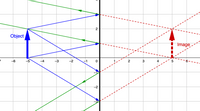
College Physics
11th Edition
ISBN: 9781305952300
Author: Raymond A. Serway, Chris Vuille
Publisher: Cengage Learning
expand_more
expand_more
format_list_bulleted
Concept explainers
Question
The ray diagram for a plane mirror is shown below. Which of the following is true about its image? Select all apply.
|
real |
|
|
virtual |
|
|
same side as the object |
|
|
opposite side as the object |
|
|
bigger than the object |
|
|
smaller than the object |
|
|
same size as the object |
|
|
upright (same orientation) |
|
|
inverted (opposite orientation) |

Transcribed Image Text:7
Object
-6
-3
-1
2
0
-2
2
3
Image
Expert Solution
This question has been solved!
Explore an expertly crafted, step-by-step solution for a thorough understanding of key concepts.
This is a popular solution
Trending nowThis is a popular solution!
Step by stepSolved in 2 steps with 2 images

Knowledge Booster
Learn more about
Need a deep-dive on the concept behind this application? Look no further. Learn more about this topic, physics and related others by exploring similar questions and additional content below.Similar questions
- The figure below shows an object (black arrow) in front of a convex mirror. How would the image produced by this mirror be classified? Select all that apply. 2f A Real Virtual Upright Inverted Smaller than the object Larger than the objectarrow_forwardUse the laws of reflection to identify which eye will see the object. Identify light rays from the object that reflect from the plane mirror into the eye. The angle of incidence must be equal to the angle of reflection.arrow_forwardTwo plane mirrors are at an angle of ?1 = 64.5° with each other as in the side view shown in the figure below. If a horizontal ray is incident on mirror 1, at what angle ?2 does the outgoing reflected ray make with the surface of mirror 2?arrow_forward
- Two plane mirrors are at an angle of 0, = 65.6° with each other as in the side view shown in the figure below. If a horizontal ray is incident on mirror 1, at what angle 0, does the outgoing reflected ray make with the surface of mirror 2? Mirror 1 Mirror 2arrow_forwardA concave mirror produces a real inverted image that is almost exactly as tall as the object itself. If the object is 15.0 cm in front of the mirror: What is center of curvature of the mirror? Show the algebraic form of any equation(s) applied and report all answers with the correct units.arrow_forwardIn the figure below, a diverging lens and concave spherical mirror are positioned along an optical axis, with an object half way between the two. The distance between the lens and mirror is d = 23.6 cm. The magnitude of the mirror's radius of curvature is 20.1 cm, and the lens has a focal length of flens = -19.0 cm. Lens Object Mirror (a) Considering only the light that leaves the object and travels first toward the mirror, locate the final image formed by this system. (Give the magnitude of the image distance in cm, and select its location with respect to the lens.) image distance image location -Select--- (b) Is this image real or virtual? O real O virtual (c) Is it upright or inverted? O upright O inverted (d) What is the overall magnification? cmarrow_forward
- Rays of light coming from the sun (a very distant object) are near and parallel to the principal axis of a concave mirror. After reflecting from the mirror, where will the rays cross each other at a single point? The rays __________ will not cross each other after reflecting from a concave mirror. will cross at the center of curvature. will cross at the point where the principal axis intersects the mirror. will cross at the focal point. will cross at a point beyond the center of curvature.arrow_forwardplease answer the question in the imagearrow_forwardTwo mirrors make an angle of 120° with each other as shown in the Figure below. A ray is incident on Mirror M1 at an angle of 65° to the normal. Find the angle the ray makes with the 2. normal to M2 after it is reflected from both mirrors. Bret Bune ef ine = 65° 120 M1arrow_forward
arrow_back_ios
arrow_forward_ios
Recommended textbooks for you
 College PhysicsPhysicsISBN:9781305952300Author:Raymond A. Serway, Chris VuillePublisher:Cengage Learning
College PhysicsPhysicsISBN:9781305952300Author:Raymond A. Serway, Chris VuillePublisher:Cengage Learning University Physics (14th Edition)PhysicsISBN:9780133969290Author:Hugh D. Young, Roger A. FreedmanPublisher:PEARSON
University Physics (14th Edition)PhysicsISBN:9780133969290Author:Hugh D. Young, Roger A. FreedmanPublisher:PEARSON Introduction To Quantum MechanicsPhysicsISBN:9781107189638Author:Griffiths, David J., Schroeter, Darrell F.Publisher:Cambridge University Press
Introduction To Quantum MechanicsPhysicsISBN:9781107189638Author:Griffiths, David J., Schroeter, Darrell F.Publisher:Cambridge University Press Physics for Scientists and EngineersPhysicsISBN:9781337553278Author:Raymond A. Serway, John W. JewettPublisher:Cengage Learning
Physics for Scientists and EngineersPhysicsISBN:9781337553278Author:Raymond A. Serway, John W. JewettPublisher:Cengage Learning Lecture- Tutorials for Introductory AstronomyPhysicsISBN:9780321820464Author:Edward E. Prather, Tim P. Slater, Jeff P. Adams, Gina BrissendenPublisher:Addison-Wesley
Lecture- Tutorials for Introductory AstronomyPhysicsISBN:9780321820464Author:Edward E. Prather, Tim P. Slater, Jeff P. Adams, Gina BrissendenPublisher:Addison-Wesley College Physics: A Strategic Approach (4th Editio...PhysicsISBN:9780134609034Author:Randall D. Knight (Professor Emeritus), Brian Jones, Stuart FieldPublisher:PEARSON
College Physics: A Strategic Approach (4th Editio...PhysicsISBN:9780134609034Author:Randall D. Knight (Professor Emeritus), Brian Jones, Stuart FieldPublisher:PEARSON

College Physics
Physics
ISBN:9781305952300
Author:Raymond A. Serway, Chris Vuille
Publisher:Cengage Learning

University Physics (14th Edition)
Physics
ISBN:9780133969290
Author:Hugh D. Young, Roger A. Freedman
Publisher:PEARSON

Introduction To Quantum Mechanics
Physics
ISBN:9781107189638
Author:Griffiths, David J., Schroeter, Darrell F.
Publisher:Cambridge University Press

Physics for Scientists and Engineers
Physics
ISBN:9781337553278
Author:Raymond A. Serway, John W. Jewett
Publisher:Cengage Learning

Lecture- Tutorials for Introductory Astronomy
Physics
ISBN:9780321820464
Author:Edward E. Prather, Tim P. Slater, Jeff P. Adams, Gina Brissenden
Publisher:Addison-Wesley

College Physics: A Strategic Approach (4th Editio...
Physics
ISBN:9780134609034
Author:Randall D. Knight (Professor Emeritus), Brian Jones, Stuart Field
Publisher:PEARSON